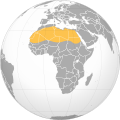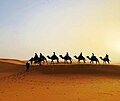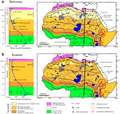Sahara
Sahara
The Sahara is the largest hot desert and the third largest desert overall after Antarctica and the Arctic. Its area of 9,200,000 square kilometers is comparable to the area of China or the United States. The desert comprises much of North Africa, excluding the fertile region on the Mediterranean Sea coast, the Atlas Mountains of the Maghreb, and the Nile Valley in Egypt and Sudan. It stretches from the Red Sea in the east and the Mediterranean in the north to the Atlantic Ocean in the west, where the landscape gradually changes from desert to coastal plains. To the south, it is bounded by the Sahel, a belt of semi-arid tropical savanna around the Niger River valley and the Sudan Region of Sub-Saharan Africa.
Geography[edit]
The Sahara can be divided into several regions including: the western Sahara, the central Ahaggar Mountains, the Tibesti Mountains, the Aïr Mountains, the Ténéré desert, and the Libyan Desert. The highest peak in the Sahara is Emi Koussi, a shield volcano in the Tibesti range of northern Chad.
Climate[edit]
The Sahara's climate consists of basically two sub-climates, a dry subtropical climate in the north and a dry tropical climate in the south. The southern part of the Sahara is characterized by high temperatures that can exceed 50 °C (122 °F) while the northern part, due to its higher altitude, is a bit cooler.
Flora and Fauna[edit]
Despite the harsh conditions, several life forms have adapted to the extreme conditions of the Sahara. Some of the plant species in the Sahara include the Acacia tree, the date palm, and several species of cactus. Animal life includes the dromedary camel, the fennec fox, and the monitor lizard.
Human History[edit]
The Sahara has been inhabited by various human groups since prehistoric times. Occupying the Sahara has presented significant challenges to those living in its fringes since the climate is extremely dry and the vegetation sparse. Several cultures have developed and fallen in the Sahara.
See Also[edit]
|
|
|
Sahara[edit]
-
Sahara
-
Vegetation Africa
-
Sahara satellite hires
-
Hoggar
-
Algeria Sahara Desert Photo From Drone
-
Sunset in Sahara
-
Journal pone 0076514 g004
-
Village Telly in Mali
-
Great green wall map
-
Saharan topographic elements map
-
Guelta Camels
-
Libya 5391 Ubari Lakes Luca Galuzzi 2007
Ad. Transform your life with W8MD's Budget GLP-1 injections from $75


W8MD offers a medical weight loss program to lose weight in Philadelphia. Our physician-supervised medical weight loss provides:
- Weight loss injections in NYC (generic and brand names):
- Zepbound / Mounjaro, Wegovy / Ozempic, Saxenda
- Most insurances accepted or discounted self-pay rates. We will obtain insurance prior authorizations if needed.
- Generic GLP1 weight loss injections from $75 for the starting dose.
- Also offer prescription weight loss medications including Phentermine, Qsymia, Diethylpropion, Contrave etc.
NYC weight loss doctor appointmentsNYC weight loss doctor appointments
Start your NYC weight loss journey today at our NYC medical weight loss and Philadelphia medical weight loss clinics.
- Call 718-946-5500 to lose weight in NYC or for medical weight loss in Philadelphia 215-676-2334.
- Tags:NYC medical weight loss, Philadelphia lose weight Zepbound NYC, Budget GLP1 weight loss injections, Wegovy Philadelphia, Wegovy NYC, Philadelphia medical weight loss, Brookly weight loss and Wegovy NYC
|
WikiMD's Wellness Encyclopedia |
| Let Food Be Thy Medicine Medicine Thy Food - Hippocrates |
Medical Disclaimer: WikiMD is not a substitute for professional medical advice. The information on WikiMD is provided as an information resource only, may be incorrect, outdated or misleading, and is not to be used or relied on for any diagnostic or treatment purposes. Please consult your health care provider before making any healthcare decisions or for guidance about a specific medical condition. WikiMD expressly disclaims responsibility, and shall have no liability, for any damages, loss, injury, or liability whatsoever suffered as a result of your reliance on the information contained in this site. By visiting this site you agree to the foregoing terms and conditions, which may from time to time be changed or supplemented by WikiMD. If you do not agree to the foregoing terms and conditions, you should not enter or use this site. See full disclaimer.
Credits:Most images are courtesy of Wikimedia commons, and templates, categories Wikipedia, licensed under CC BY SA or similar.
Translate this page: - East Asian
中文,
日本,
한국어,
South Asian
हिन्दी,
தமிழ்,
తెలుగు,
Urdu,
ಕನ್ನಡ,
Southeast Asian
Indonesian,
Vietnamese,
Thai,
မြန်မာဘာသာ,
বাংলা
European
español,
Deutsch,
français,
Greek,
português do Brasil,
polski,
română,
русский,
Nederlands,
norsk,
svenska,
suomi,
Italian
Middle Eastern & African
عربى,
Turkish,
Persian,
Hebrew,
Afrikaans,
isiZulu,
Kiswahili,
Other
Bulgarian,
Hungarian,
Czech,
Swedish,
മലയാളം,
मराठी,
ਪੰਜਾਬੀ,
ગુજરાતી,
Portuguese,
Ukrainian














